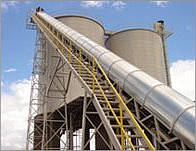Transporting biomass between chippers, classifiers, silos, dryers, and biomass burners
 Biomass material can be transported in various different forms. The most appropriate transportation option will depend on the type of biomass, quantity, and density.
Biomass material can be transported in various different forms. The most appropriate transportation option will depend on the type of biomass, quantity, and density.
Transportation options
- Belt conveyor or conveyor belt
- Screw conveyor
- Extractor screw
- Bucket elevator
- Vibratory conveyor
- Chain conveyor
- Pneumatic conveyor
- Receiving and dosing table
- Dosing valve
Extracting biomass from the storage facility
 Extraction ease
Extraction ease
The design and implementation of biomass storage should take into account the ease of extraction of its contents and the required quantity for the next destination, whether it is a boiler, combustion unit, conversion plants, briquetting plants, or any other need. If convenient, the use of natural gravity should be applied, reducing the need for energy.
Discharge point
 It is important to design the storage system in such a way that the contents, such as pellets, wood chips, or sawdust, can flow to the storage discharge point. This discharge point should not have regions where biomass can accumulate or get stuck, forming areas where biomass can remain indefinitely and potentially allow the growth of mold and fungi.
It is important to design the storage system in such a way that the contents, such as pellets, wood chips, or sawdust, can flow to the storage discharge point. This discharge point should not have regions where biomass can accumulate or get stuck, forming areas where biomass can remain indefinitely and potentially allow the growth of mold and fungi.
Transferring biomass from the storage
There are several methods for transferring biomass, and depending on the situation, different methods, materials, and results are achieved.
Possible methods include:
- Natural gravity or use of compressed air
- Extractor screws
- Conveyor belts
- Pneumatic systems
-
Fuel type and specifications
Biomass systems can be designed to make use of a wide range of raw materials, and wood fuels vary greatly in size and type, from logs to wood chips and wood pellets. Each type of fuel has its own specific calorific value and burning patterns, and the classification and quality of these factors should be carefully analyzed in the initial project phase, with specialized consulting.
Products for biomass movement and dosing
Within the biomass production process for energy purposes, biomass material can be transported in various different forms. The most appropriate transportation option will depend on the type of biomass, quantity, and density.